Gate Research: QTUM and NEO Surge|USDC Usage on Ethereum Hits All-Time High
Crypto Market Overview
BTC (-1.84% | Current Price: 112,885 USDT)
BTC is currently trading around 112,800 USD, showing a short-term downward consolidation. On August 23, BTC experienced a strong rally, briefly reaching a high of 117,417 USD, but failed to hold and subsequently retraced. The price has now fallen below the 5-, 10-, and 30-hour moving averages, forming a bearish alignment and indicating weak short-term technical momentum.
Volume analysis shows that the pullback is accompanied by increasing volume, particularly noticeable when breaking below 113,000 USD, signaling strong selling pressure. Key support is at 110,600 USD (recent lows); a break below this level may test the 110,000 USD psychological level. Resistance lies between 114,500–115,000 USD, and only a rebound above this range could signal a recovery of the downtrend.
Overall, BTC shows short-term bearish bias. Maintaining the 110,600 USD support is crucial; if volume contracts and the price stabilizes, an oversold rebound could occur. Otherwise, further downside is likely.
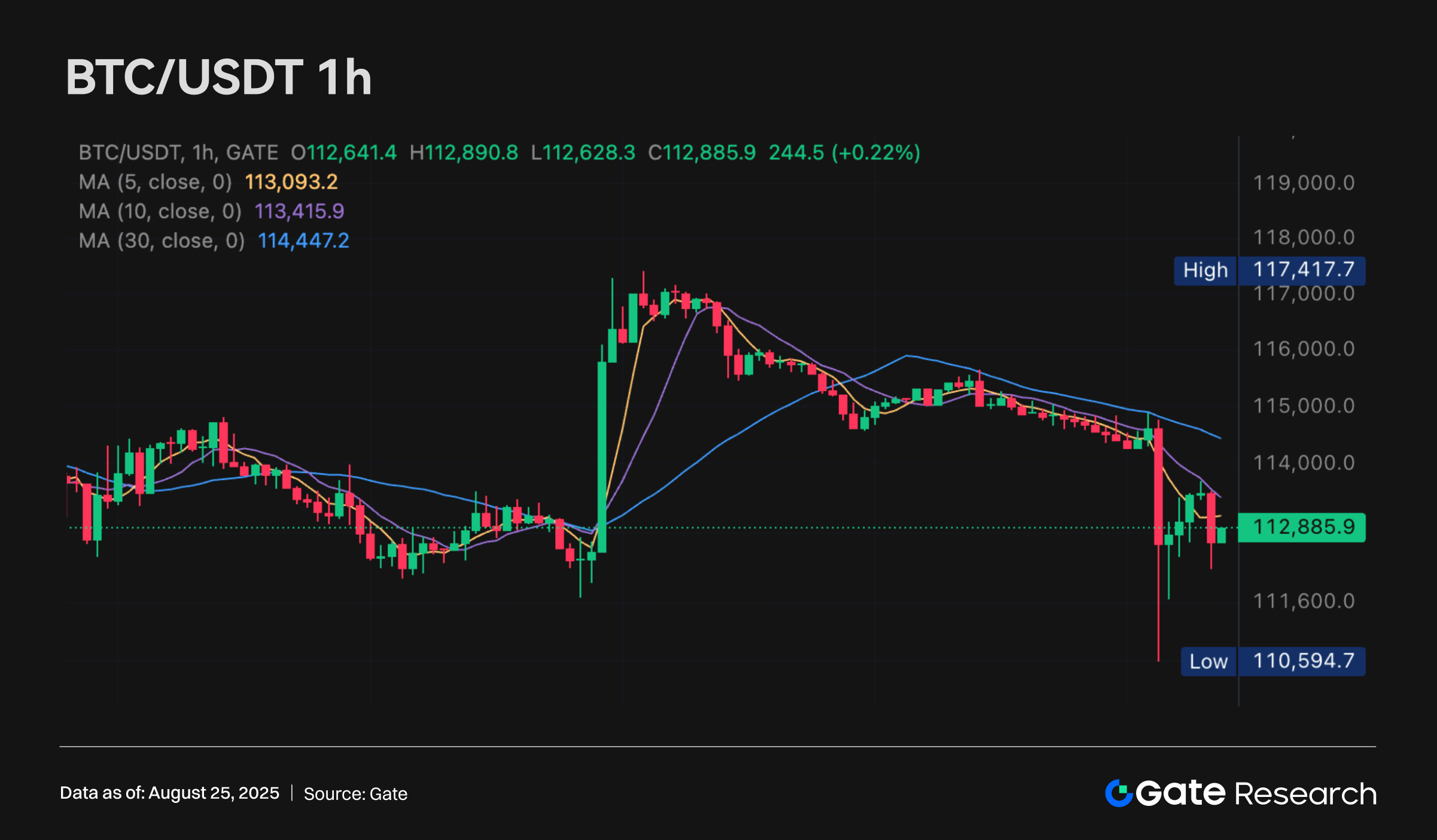
Additionally, on August 22, BTC ETFs saw a net outflow of 23.2 million USD, with BlackRock IBIT outflowing 198 million USD and Fidelity FBTC inflowing 50.9 million USD.
ETH (-0.63% | Current Price: 4,739 USDT)
ETH’s price trend closely mirrors BTC. On August 23, ETH surged to 4,956 USD but failed to break the 5,000 USD psychological level, entering sideways consolidation and experiencing a slight pullback on August 25.
The 5- and 10-hour moving averages have crossed below the 30-hour MA, showing weakening short-term momentum. Volume expanded during the initial breakout but remained moderate during the subsequent pullback, indicating a technical correction rather than strong selling pressure.
Key support lies between 4,700–4,680 USD; if broken, ETH could further retest 4,500 USD. Resistance remains at 4,950–5,000 USD; a decisive breakout could open upside toward 5,200 USD.
Overall, ETH is in a consolidation phase, with price oscillating between critical support and resistance levels. Holding 4,700 USD and gradually gaining upward momentum could resume the bullish trend, while failure may trigger further declines.
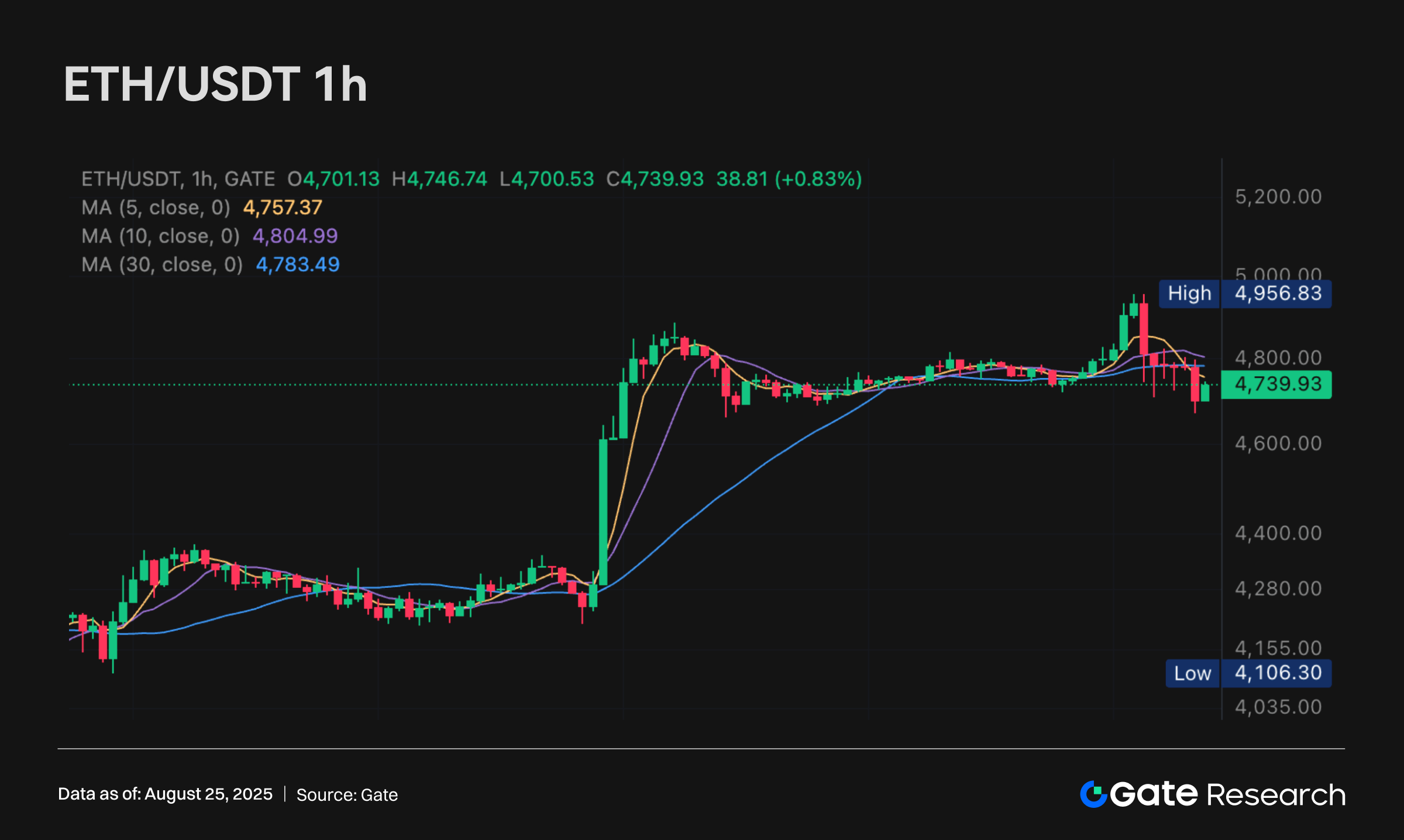
On August 22, ETH ETFs recorded a net inflow of 337 million USD, with BlackRock ETHA inflowing 109 million USD and Fidelity FETH inflowing 117 million USD.
GT (-3.06% | Current Price: 17.54 USDT)
GT is currently trading around 17.54 USD, showing a high-to-low consolidation pattern in recent days. On August 22, the price briefly reached 19.37 USD but quickly retraced. It then entered a downward channel, hitting a recent low of 16.92 USD on August 25.
The 5- and 10-hour moving averages have crossed below the 30-hour MA and are diverging downward, indicating short-term bearish dominance. Volume increased during the upward move but did not spike during the pullback, reflecting gradual selling pressure rather than panic selling.
Key support is near 16.90 USD; a break could push the price further toward 16.30 USD. Resistance lies between 17.80–18.00 USD, with a break required to challenge 18.50 USD.
Overall, GT remains in a short-term downtrend. Without a quick recovery above 18 USD, the market may continue to trend sideways with a bearish bias. Traders should closely monitor the 16.90 USD support level for potential stabilization.
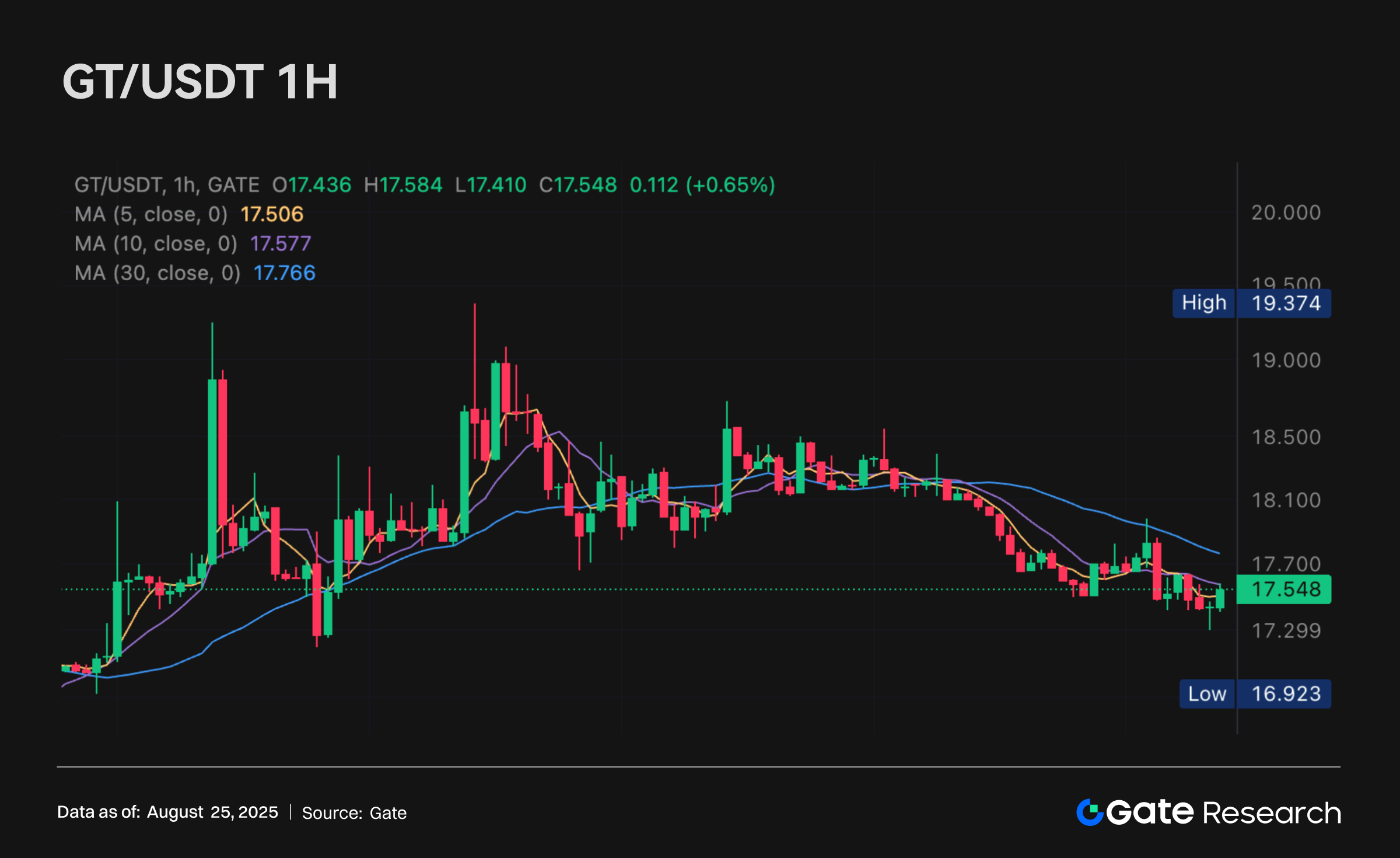
Tokens Heatmap
Despite the overall market entering a correction phase, certain mid- and small-cap tokens have posted impressive gains. NEON (+46.89%), QTUM (+33.25%), and similar tokens saw explosive rallies, indicating active capital inflows into niche sectors. Meanwhile, tokens like WILD (-11.49%) experienced significant pullbacks, reflecting rapid shifts in market hotspots and increased speculative behavior. In contrast, major tokens such as BTC and ETH faced correction pressure, with some affected by temporary negative factors, resulting in relatively constrained performance.
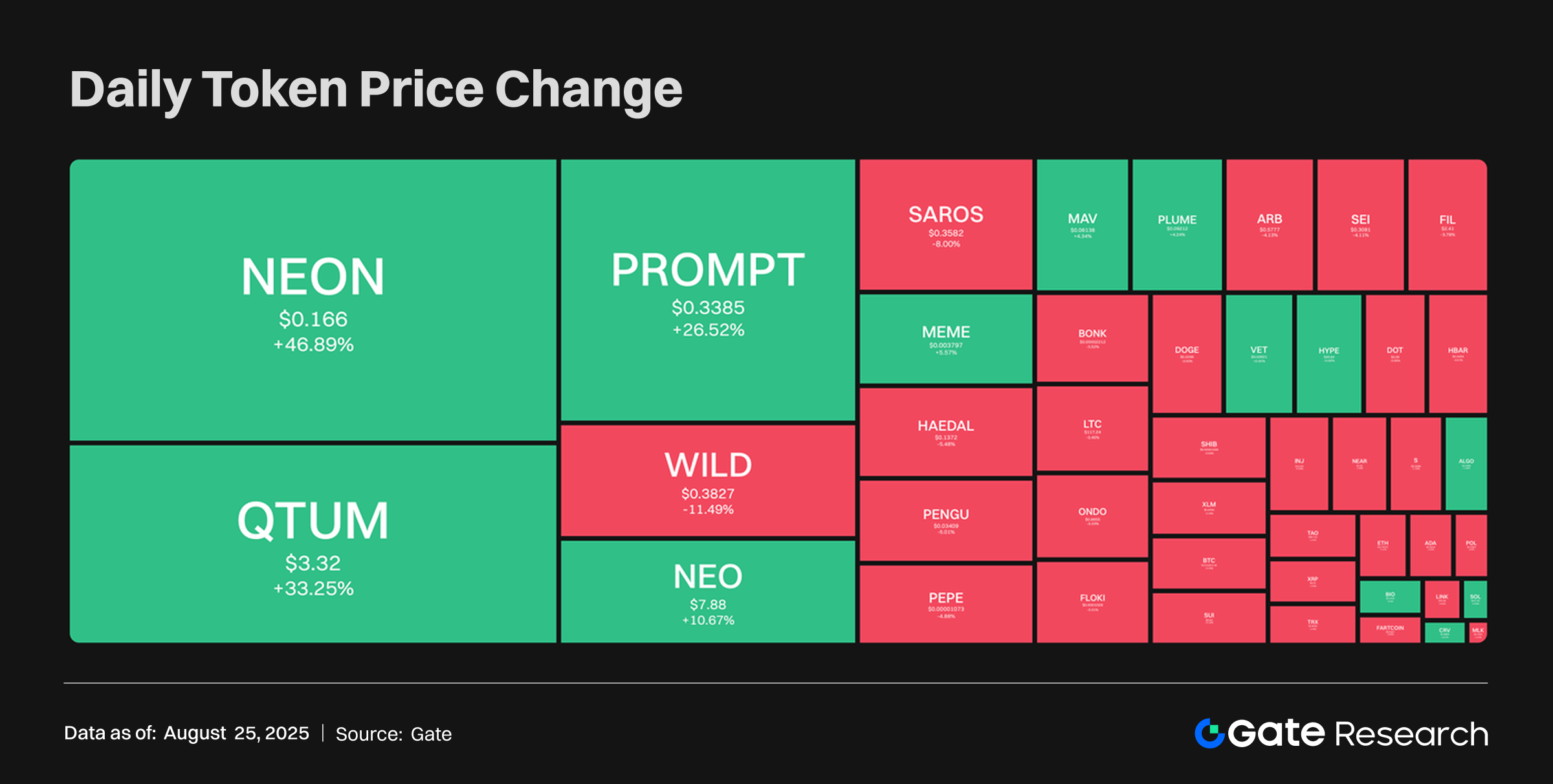
NEON — NEON EVM (+46.89%, Market Cap: 39.21M USD)
According to Gate data, NEON is currently priced at 0.166 USD, up 46.89% in 24 hours. NEON EVM is an Ethereum Virtual Machine solution deployed on the Solana blockchain, providing a fully EVM-compatible environment that allows Ethereum dApps to run on Solana without code modification.
Solana maintains a leading position in performance and adoption, and NEON leverages EVM composability to capitalize on this trend. Recently, NEON was integrated into a European fintech company’s crypto card payment platform, enabling global crypto spending. Price-wise, NEON had long consolidated in the 0.08–0.09 USD range with low trading volume. Starting August 24, a surge of capital pushed the price above the consolidation zone, signaling accelerated inflows and a fundamental shift in market sentiment.
QTUM — Qtum (+33.25%, Market Cap: 348M USD)
According to Gate data, QTUM trading at 3.32 USD, up approximately 33.25% in 24 hours. Qtum is an open-source blockchain platform combining Bitcoin’s security (UTXO model) with Ethereum’s smart contract capabilities, using a PoS consensus mechanism for energy efficiency. QTUM is used to pay transaction fees, participate in governance voting, and earn staking rewards.
Recently, Qtum announced a partnership with umycomofficial, enabling users to pay with Qtum for travel experiences and cost savings. Technically, QTUM broke out strongly after a long consolidation, with multiple bullish candlesticks accompanied by high volume, surpassing long-term resistance. The price hit a high of 3.487 USD, marking a new peak since May, and currently trades at 3.32 USD. This breakout suggests sentiment has shifted from cautious to bullish, and sustained high volume could maintain QTUM’s upward momentum.
NEO — Neo (+10.67%, Market Cap: 551M USD)
According to Gate data, NEO is currently trading at 7.88 USD, up about 10.67% in 24 hours. NEO is a community-driven open-source platform that leverages blockchain and digital identity to enable asset management automation via smart contracts. The project aims to build next-generation Internet infrastructure through distributed networks, laying the foundation for large-scale blockchain adoption and realizing a smart economy vision.
Neo X recently launched ZK Trust Relay, supporting its Anti-MEV solution via a Distributed Key Generation (DKG) zero-knowledge encryption protocol, audited by multiple institutions for security. Since mid-August, NEO’s price has steadily risen alongside significantly increased trading volume. It has recently broken previous resistance levels, reaching a high of 8.49 USD. NEO now trades above all major moving averages, with a bullish alignment, indicating a strong upward trend.
Hotpot Insights
USDC Usage on Ethereum Hits All-Time High with $748.3 Billion Monthly Transfers
According to Token Terminal, USDC usage on the Ethereum network reached a record high. In July 2025, monthly USDC transfers totaled $74.83 billion, up approximately 300% from the January 2024 low, with 8.3 million transactions executed. Industry experts note that this transaction volume is approaching the scale of traditional large banking systems, highlighting USDC’s strong liquidity and wide-ranging applications within the stablecoin market.
The surge in USDC usage on Ethereum reflects its evolving role as an “on-chain dollar,” serving as a key bridge between crypto markets and real-world value flows. This growth is driven not only by the continued expansion of DeFi and on-chain payment solutions but also by rising trust in compliant stablecoins among institutional and retail users. As USDC’s transaction volumes approach those of traditional banks, stablecoins may play an increasingly central role in future financial infrastructure—albeit under closer regulatory scrutiny.
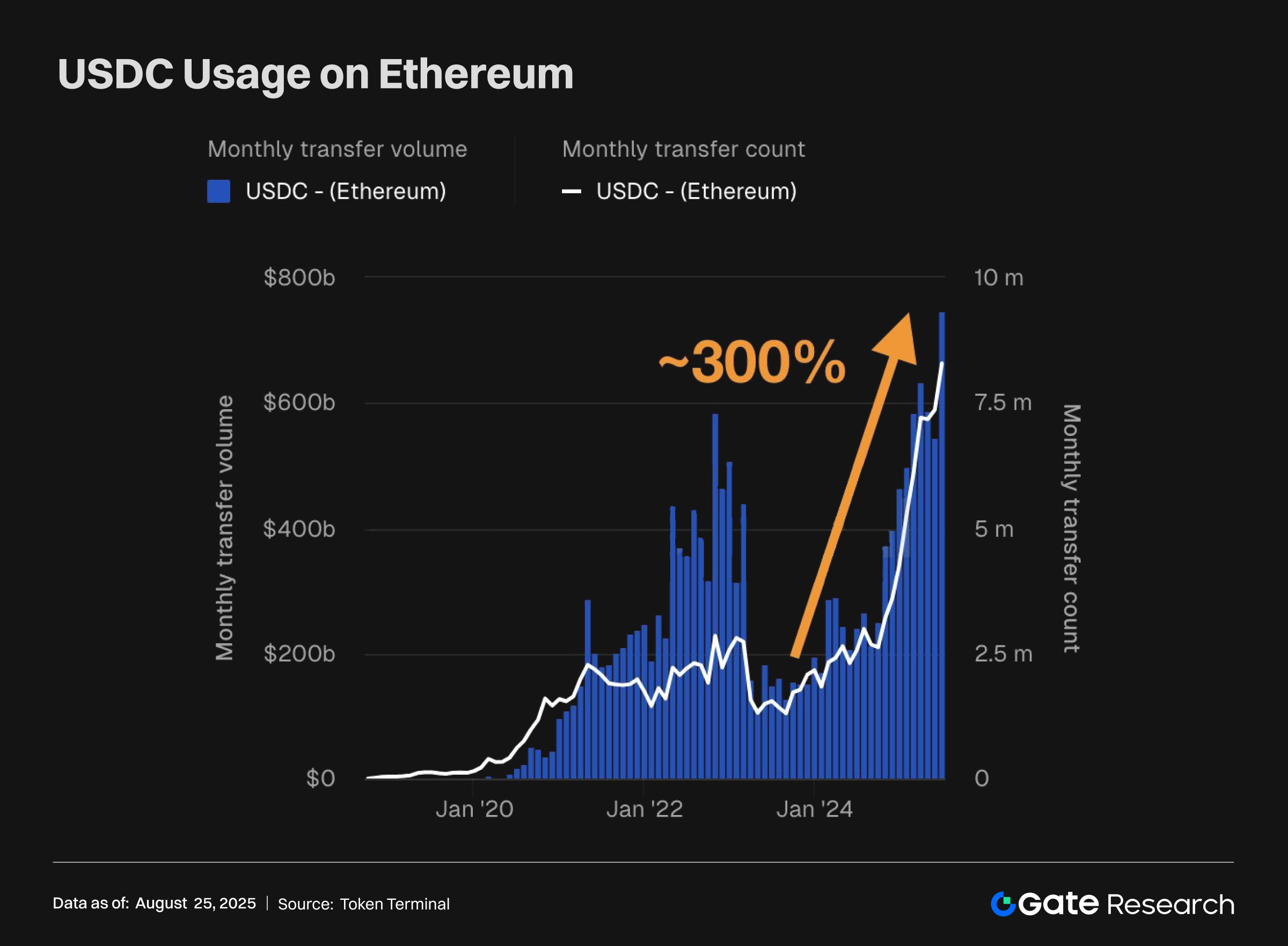
Hong Kong Monetary Authority to Implement Basel Crypto Asset Capital Rules from January 1, 2026
The Hong Kong Monetary Authority (HKMA) announced that it will fully implement the Basel Committee’s new capital requirements for crypto assets starting January 1, 2026. This move brings crypto assets under the international banking capital framework, making Hong Kong one of the first jurisdictions to enforce these standards rigorously.
Under the new rules, crypto assets using permissionless blockchain technology may carry a risk weight of up to 1250%, meaning banks must allocate capital on a 1:1 basis to cover the associated risk exposure. Experts warn that the high capital cost may discourage most banks from holding such high-risk crypto assets directly.
Hong Kong’s regulatory update underscores its forward-looking approach to compliance and risk management while signaling that traditional financial institutions will adopt a highly cautious path toward crypto adoption. In the short term, this may reduce banks’ willingness to hold crypto directly and limit market demand. In the long term, however, standardized capital requirements are expected to enhance market transparency and financial stability, laying a solid institutional foundation for compliant participation in the crypto ecosystem.
SBI Group Partners with Chainlink to Accelerate Global Institutional Adoption of Digital Assets
SBI Group (SBI) announced a strategic partnership with Chainlink aimed at accelerating the adoption of blockchain and digital assets in global financial markets. The collaboration focuses on key institutional use cases in Japan and the Asia-Pacific region, including cross-chain transfers of tokenized real-world assets such as real estate and bonds; integration of the Cross-Chain Interoperability Protocol (CCIP) for secure cross-chain transactions with compliance and privacy protections; and using CCIP with Chainlink SmartData to transmit NAV data of on-chain tokenized funds, enhancing liquidity and operational efficiency.
Additionally, the partnership will leverage Chainlink CCIP for PvP settlement in FX and cross-border transactions and utilize Chainlink Proof of Reserve to provide transparent on-chain verification of stablecoin reserves.
This strategic collaboration exemplifies the deepening convergence of traditional financial institutions and blockchain infrastructure providers. The joint efforts of SBI and Chainlink not only offer secure and efficient digital asset solutions to financial institutions but also advance tokenization of real-world assets, cross-chain interoperability, and stablecoin transparency. For the market, it signals accelerated institutional adoption of digital assets in the Asia-Pacific region and highlights the practical value of blockchain technology in compliant, transparent, and efficient financial operations.
References
- Gate, https://www.gate.com/trade/BTC_USDT
- Farside Investors, https://farside.co.uk/btc/
- Gate, https://www.gate.com/trade/ETH_USDT
- Farside Investors, https://farside.co.uk/eth/
- Gate, https://www.gate.com/trade/GT_USDT
- Gate, https://www.gate.com/price
- X, https://x.com/tokenterminal/status/1959628031233835258
- caixin, https://finance.caixin.com/2025-08-23/102354563.html
- PR Newswire, https://www.prnewswire.com/news-releases/sbi-group-and-chainlink-announce-strategic-partnership-to-accelerate-institutional-digital-asset-adoption-in-key-global-markets-302537166.html
Gate Research is a comprehensive blockchain and cryptocurrency research platform that provides deep content for readers, including technical analysis, market insights, industry research, trend forecasting, and macroeconomic policy analysis.
Disclaimer
Investing in cryptocurrency markets involves high risk. Users are advised to conduct their own research and fully understand the nature of the assets and products before making any investment decisions. Gate is not responsible for any losses or damages arising from such decisions.
Related Articles

Exploring 8 Major DEX Aggregators: Engines Driving Efficiency and Liquidity in the Crypto Market

What Is Copy Trading And How To Use It?

How to Do Your Own Research (DYOR)?

What Is Technical Analysis?

What Is Fundamental Analysis?
